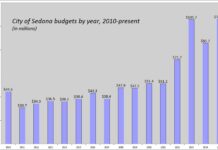Lowering the mil levy rate for its 2008-09 fiscal year was the first order of discussion at the Sedona Fire District Governing Board meeting Feb. 27.
Mil levy is the term for the district’s tax rate which is applied against the assessed property value made by Yavapai County and Coconino County.
An example of the mil levy tax calculation for a home
with a market value of half-a-million dollars:
$500,000 market value times 0.10 assessment ratio [Yavapai County] times 0.0175 SFD mil levy rate [for 2007-08] = $875.
By Susan Johnson
Larson Newspapers
Lowering the mil levy rate for its 2008-09 fiscal year was the first order of discussion at the Sedona Fire District Governing Board meeting Feb. 27.
Mil levy is the term for the district’s tax rate which is applied against the assessed property value made by Yavapai County and Coconino County.
An example of the mil levy tax calculation for a home
with a market value of half-a-million dollars:
$500,000 market value times 0.10 assessment ratio [Yavapai County] times 0.0175 SFD mil levy rate [for 2007-08] = $875.
SFD’s tax rate is calculated after the counties release their total net assessed values for all properties within the boundaries of the district and after the district makes final decisions on upcoming capital projects and has a best estimate
of its operating costs for the coming year.
While the bulk of the district’s revenues come from taxes, it also collects service fees, receives funds from the sale of vehicles, collects interest income and has cash reserves that add up to a little more than $2 million for this fiscal year.
After this number is subtracted from its costs, the remainder is the number the district needs from property owners.
For 2008, total net values within the SFD boundaries are nearly $800 million.
In Yavapai County, that’s a 20 percent increase over 2007 while Coconino County posted an 11 percent increase.
According to Yavapai County Assessor Victor Hambrick, two criteria affect the total: new construction and the average actual sale prices of existing properties in the year 2005 and the first half of 2006.
An increase or decrease in the sales price of one property recalibrates entire neighborhoods rather than just the property that was sold.
If one house in a neighborhood is sold for twice its previously assessed value, the entire neighborhood’s values are elevated by the same percentage for purposes of the county’s calculation.
While market values were strong in 2005 and early 2006, Hambrick said that sales figures in the latter part of 2006 and for 2007 showed declines.
These lowered valuations will show up in the 2009 net assessed valuations.
Budget discussions for the district began in late January and will result in a final budget presented to taxpayers by the end of April.
After that, the budget may not be increased, but may be lowered if necessary.
SFD Fire Chief Matt Shobert told the board that, due to the large jump in assessed valuations, he felt the district was well-positioned to drop the mil levy by at least $0.07 or $0.08 for the fiscal year that begins Tuesday, July 1, and still have adequate operating and capital improvement funds for ongoing projects and also reserve funds for upcoming projects.
Those include construction of a new fire station in the Chapel area, relocating the Oak Creek Canyon station to a more northern site
and rebuilding the district’s communication center.
Due to the high cost of each project, the district is working to build its cash reserves over the course of several years, beginning last fiscal year.
Governing Board members expressed concern that lowering the rate for the upcoming year could subject the district to a shortfall if property valuations subsequently decrease.
“Looking at the market [valuations], if they go down, we’ll be getting ahead of ourselves,” Joy Moore, a board member, said.
Tom Wells, also a board member, is in favor of lowering the rate, but questions the timing.
“My concern is if we lower it now and then if the tax revolt goes through, it will have a big impact on us,” Wells said.
Liza Vernet, the newest member on the board, expressed her concern regarding the suggested rate drop vis-à-vis the district’s exposure to energy costs.
“Electricity, fuel, tires and medical equipment are all going up,” Vernet said.
However, Shobert said revenues from ambulance and other services provided by staff to neighboring communities are projected to increase next year offsetting those higher costs.
Sedona currently has the second lowest mil levy rate of all neighboring communities that do not receive funds through a city budget process.
The fire departments in Cottonwood, Flagstaff and Prescott are funded by the respective cities.
Only Clarkdale, which has one firefighter, has a lower rate.
All other things being equal to the calculation shown above, based on mil levy rates in the respective communities for the current year, the same $500,000 homeowner in Chino Valley would pay $1,474 for all services that the fire district provides and in Camp Verde would pay $1,237.
No decisions regarding the budget were made by the board at the meeting.
The next board budget workshop will be held Saturday, March 22, from noon to 3 p.m. at Station 1 in West Sedona at 2860 Southwest Drive.
Residents are invited and may participate in the discussions.
Susan Johnson can be reached at 282-7795, Ext. 129 or e-mail sjohnson@larsonnewspapers.com





















